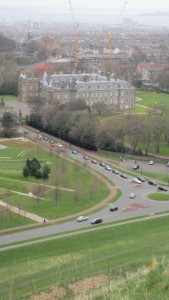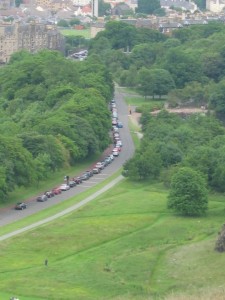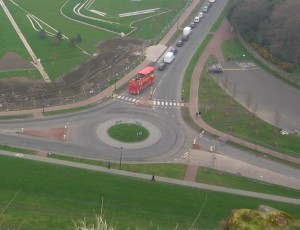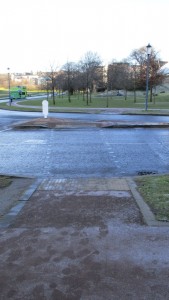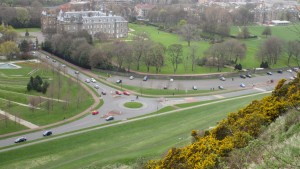Action Points for the City of Edinburgh Council
1 CEC should set a ‘Vision Zero’ target of no deaths or serious injuries on its roads, within its new Road Safety Plan, with a target of 2030 for realising that vision. (A more ambitious target than the national one is realistic in Edinburgh, where speeds are lower and road safety problems are less diverse.)
2 Excessive speeding is the principal source of the collisions that result in casualties. Realising this vision will require stronger and more comprehensive actions to reduce speeds on the city’s roads. Stronger measures both to enforce speed limits, and to redesign streets are essential.
3 Maximum use should be made of both fixed and mobile speed cameras, and red light cameras for enforcement. Suitable technology should be employed to ensure that the breaking of all speed limits (from 20 to 70 mph) can be enforced. Successful schemes on main roads using average speed cameras, such as that on Dalkeith Rd, should be rolled out across the city. But camera deployments must also be targeted by evidence of highly excessive speeds, not just by whether these have yet resulted in collisions.
4 Enforcement of 20mph limits across the city is never likely to be a priority for the police however, and CEC initiative and support will be essential. Involvement of the public and community groups, through initiatives such as ‘Speedwatch’, is vital for the identification of speeding problems and targeting of enforcement efforts on residential streets.
5 With the necessary legal powers, the council could readily undertake enforcement actions, alongside and co-ordinated with the police, under a system analogous to that for parking offences. Lesser speeding offences should be subject to fines issued by council wardens, with evidence of more serious abuses passed on for action by the police. CEC should seek the necessary devolved powers for such an enforcement system, with the fines set to fully fund the costs of enforcement.
6 A renewed emphasis on street redesign is needed, with the full range of traffic calming measures flexibly used wherever required. More use of soft measures such as speed indicator signs can be helpful, but they are no substitute for the hard engineering measures such as humps, cushions, and speed tables that effectively curb speeds. A single road hump on the approach to a sharp bend for example can eliminate a serious risk. Perceptions of safety are also very important for pedestrians and are an additional benefit on traffic calmed streets.
7 Raised crossings should become the norm on residential streets with 20mph limits. There should be a presumption that all new crossings, whether formal or informal, should be raised, with appropriate tactile paving, making them safer and easier to use for pedestrians. Especially where located at the approaches to junctions the slower speeds would have additional traffic calming benefits.
8 The current CEC safety review of major junctions is very welcome and needs to be made comprehensive. There are also still a multitude of more minor junctions with dangerous wide splay entrances that need to be redesigned. A new targeted review and investment programme is needed to systematically improve them, with tighter radii, build outs and raised entrances, as appropriate.
9 School safety plans are needed that provide for safer routes and for the safer school entrance areas that are needed at many of the city’s schools. Wider pavements should be provided that allow for the concentration of pedestrian activity these areas inevitably attract, with reduced parking and less use of guardrail.
10 Many pavements in the city are sub-standard, and often far too narrow. A comprehensive review and investment programme is needed to widen pavements and meet minimum design standards wherever possible. Where narrower carriageway widths result this will often also help to slow traffic speeds.
Action Points for the Scottish Government
1 ‘Vision Zero’ has strong public support, but to be realistic it requires more resources to support camera enforcement of speed limits at national and local level. Fines should be set at increased levels to ensure that finance will be available to support sufficiently comprehensive enforcement efforts, independent of the more general state of public finances.
2 Fines and license penalties should be graduated by the degree of excessive speeding involved and should be applicable to employers as well as individual drivers, where there is evidence of repeat offending.
3 Powers should be devolved to local authorities to allow them to undertake proportionate enforcement actions through wardens and levy fines for offences including speeding, red light jumping, pavement cycling and illegal use of e-scooters in co-ordination with the police. This will be vital for effective enforcement efforts where 20 mph limits apply across residential areas, with police resources and priorities necessarily being stretched.
4 National driver and employer education campaigns should be undertaken on the consequences of speeding, aimed at making speeding as socially unacceptable as driving with excess alcohol has become.
5 More advice and resources should be made available to local authorities to support the creation of safer streets through redesign and traffic calming. There is still a massive design deficit in terms of safety, but local authority road safety budgets and teams have been severely cut over recent years. Without strong and prioritised central government support, ‘vision zero’ will remain a mirage on many local authority streets.
Living Streets Edinburgh Group
November 2021
